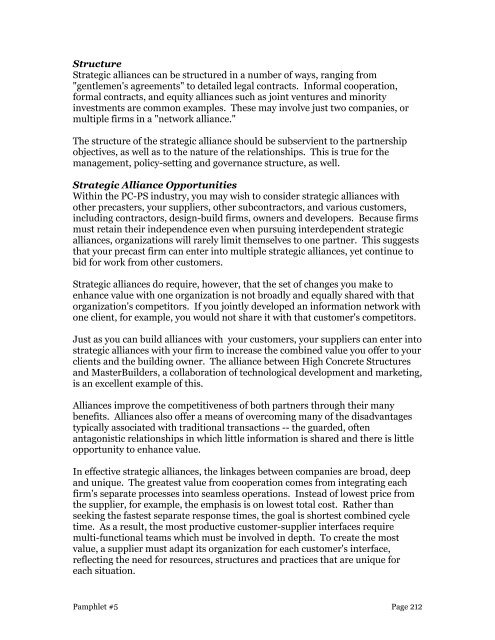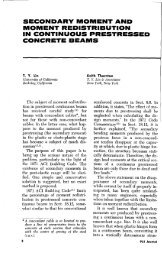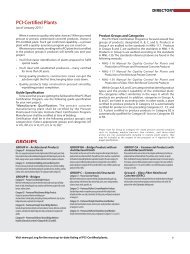Winning Without Competition: How to Break Out of a Commodity ...
Winning Without Competition: How to Break Out of a Commodity ...
Winning Without Competition: How to Break Out of a Commodity ...
You also want an ePaper? Increase the reach of your titles
YUMPU automatically turns print PDFs into web optimized ePapers that Google loves.
Structure<br />
Strategic alliances can be structured in a number <strong>of</strong> ways, ranging from<br />
"gentlemen's agreements" <strong>to</strong> detailed legal contracts. Informal cooperation,<br />
formal contracts, and equity alliances such as joint ventures and minority<br />
investments are common examples. These may involve just two companies, or<br />
multiple firms in a "network alliance."<br />
The structure <strong>of</strong> the strategic alliance should be subservient <strong>to</strong> the partnership<br />
objectives, as well as <strong>to</strong> the nature <strong>of</strong> the relationships. This is true for the<br />
management, policy-setting and governance structure, as well.<br />
Strategic Alliance Opportunities<br />
Within the PC-PS industry, you may wish <strong>to</strong> consider strategic alliances with<br />
other precasters, your suppliers, other subcontrac<strong>to</strong>rs, and various cus<strong>to</strong>mers,<br />
including contrac<strong>to</strong>rs, design-build firms, owners and developers. Because firms<br />
must retain their independence even when pursuing interdependent strategic<br />
alliances, organizations will rarely limit themselves <strong>to</strong> one partner. This suggests<br />
that your precast firm can enter in<strong>to</strong> multiple strategic alliances, yet continue <strong>to</strong><br />
bid for work from other cus<strong>to</strong>mers.<br />
Strategic alliances do require, however, that the set <strong>of</strong> changes you make <strong>to</strong><br />
enhance value with one organization is not broadly and equally shared with that<br />
organization's competi<strong>to</strong>rs. If you jointly developed an information network with<br />
one client, for example, you would not share it with that cus<strong>to</strong>mer's competi<strong>to</strong>rs.<br />
Just as you can build alliances with your cus<strong>to</strong>mers, your suppliers can enter in<strong>to</strong><br />
strategic alliances with your firm <strong>to</strong> increase the combined value you <strong>of</strong>fer <strong>to</strong> your<br />
clients and the building owner. The alliance between High Concrete Structures<br />
and MasterBuilders, a collaboration <strong>of</strong> technological development and marketing,<br />
is an excellent example <strong>of</strong> this.<br />
Alliances improve the competitiveness <strong>of</strong> both partners through their many<br />
benefits. Alliances also <strong>of</strong>fer a means <strong>of</strong> overcoming many <strong>of</strong> the disadvantages<br />
typically associated with traditional transactions -- the guarded, <strong>of</strong>ten<br />
antagonistic relationships in which little information is shared and there is little<br />
opportunity <strong>to</strong> enhance value.<br />
In effective strategic alliances, the linkages between companies are broad, deep<br />
and unique. The greatest value from cooperation comes from integrating each<br />
firm's separate processes in<strong>to</strong> seamless operations. Instead <strong>of</strong> lowest price from<br />
the supplier, for example, the emphasis is on lowest <strong>to</strong>tal cost. Rather than<br />
seeking the fastest separate response times, the goal is shortest combined cycle<br />
time. As a result, the most productive cus<strong>to</strong>mer-supplier interfaces require<br />
multi-functional teams which must be involved in depth. To create the most<br />
value, a supplier must adapt its organization for each cus<strong>to</strong>mer's interface,<br />
reflecting the need for resources, structures and practices that are unique for<br />
each situation.<br />
Pamphlet #5 Page 212







